Aberystwyth Town FC was officially formed in 1884, and played, as it still does, in the Welsh League, with its home at Park Avenue. It is one of the foremost clubs in mid Wales, and is well supported locally. Several men who played football for the club fought and died during both world wars, but the most famous of them all was Leigh Roose, the Welsh International goalkeeper. I have not got a photograph of the club war memorial, only a transcription of the names, from which I have built the short biographies below.
The Great War, 1914-1918
Thomas Cartwright, Bombardier, 730060, Royal Field Artillery. Tom was born in Market Drayton, Shropshire on 13 January 1884, the son of Henry and Evelyn Cartwright. He was a local postman and well known in Aberystwyth as a former player and secretary of Aberystwyth Town FC. Thomas married Edith Mary Banford at Aberystwyth in 1903. He was a pre-war territorial with the Cardigan Battery, and reported for duty at the Drill Hall in Aberystwyth on 4 August 1914. Following training and home duties the battery left for Egypt in December 1915 but soon after Tom returned home having completed his period of service. Later in 1916 Tom rejoined the army and was posted to the 85th Battery 11th Brigade, Royal Field Artillery. During the Third Battle of Ypres he was severely wounded in the back and was taken to 61 Casualty Clearing Station where he died of his wounds on 7 October 1917, aged 32. Tom is buried in Dozinghem Military Cemetery, Belgium.
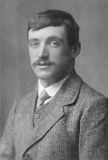
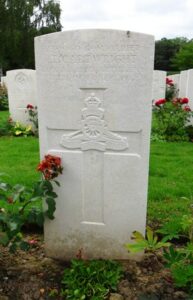
David Rees Davies, Sergeant, 14400, Kings Shropshire Light Infantry. David was the son of Aberystwyth Councillor David Davies, and of Eliza Jane Davies, and was employed at Lloyds Bank. He played football for Aberystwyth Town FC at centre forward. David joined the 7th Battalion, Kings Shropshire Light Infantry along with his close friend Edward David Evans on the same day in September 1914. The battalion was attached to 76 Brigade, 25th Division, and landed at Boulogne on 28 September 1915. On 15 October 1915 the Brigade moved to the 3rd Division, and on 19 October 1915 the battalion transferred to 8 Brigade in the same Division. In 1915 the Division saw action at Bellewaarde and Hooge, and took part in the Second attack on Bellewaarde. In 1916 the Division fought at the Actions of the Bluff, and at the St Eloi Craters. On 1 May 1916 David had volunteered to take up a forward position in the front line at Dickebusch. Sadly, the position was hit by shellfire, mortally wounding David. He died of his wounds that same day, before he could be taken to a dressing station. David was 23 years old, and is buried in La Clytte Military Cemetery, Belgium.
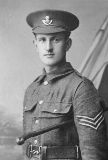
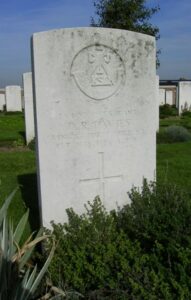
John Richard Davies, Private, 8546, Royal Welsh Fusiliers. Richard, known locally as Dick, was the son of Richard and Sarah Davies, of 1, Penglais Road, Aberystwyth. Dick played football for Aberystwyth Town FC and was a local postman who had who had served in India for seven years as a regular soldier. At the outbreak of war, he rejoined his regiment, the 2nd Battalion, Royal Welsh Fusiliers, and embarked for France, where it was attached to 19 Infantry Brigade, under independent command. The Brigade took part in the retreat from Mons to the Marne, where John rescued a wounded comrade under heavy fire at La Ferté-sous-Jouarre. The BEF then headed for Ypres, where 19 Brigade became attached to the 6th Division, and fought at the First Battle of Ypres. On 31 May 1915 the Brigade transferred to the 27th Division, and three months later transferred to the 2nd Division, taking part in the Battle of Loos. The 2nd RWF suffered terrible casualties at Loos, and remained in the Cambrin sector over the winter. On 15 March 1916, John was with ‘A’ Company, which was in the front line at the Brickstacks, when he was killed by a German rifle grenade. He was 29 years old, and is buried in Cambrin Military Cemetery, France.
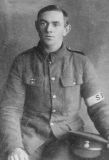
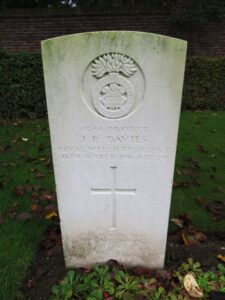
Edward Dickinson, Captain, Yorkshire Regiment. Edward was born at Burnley in 1886, the son of Doctor David Dickinson and Jane Dickinson. He had played football for Aberystwyth Football Club whilst at Aberystwyth University, and was science master at Darlington Technical College prior to the war. Edward enlisted into the Durham Light Infantry at the outbreak of war, and on 24 October 1914 was commissioned into the 11th Battalion, Yorkshire Regiment (The Green Howards). In November he became a full Lieutenant, and on 29 December 1914 was gazetted as Captain. In May 1915 Edward was transferred to the 1st Battalion, Royal Dublin Fusiliers and left England on 25 May 1915 for the Dardanelles with reinforcements. He arrived at Cape Helles on 14 June 1915, joining the battalion, which was attached to 86 Brigade, 29th Division. The battalion had seen heavy fighting since the landings of 25 April 1915. Edward was killed at Gallipoli on 28 June 1915. He was 29 years old, and is commemorated on the Helles Memorial, Gallipoli.
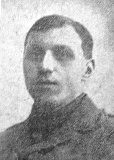
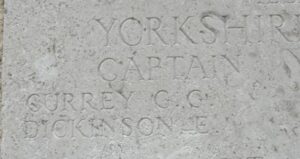
Anwyl Ellis, Lieutenant, Royal Naval Volunteer Reserve. Anwyl was the son of David and Catherine Ellis of Aberystwyth. He had played football for Aberystwyth FC, prior to becoming professor of navigation at Glasgow University, and was a Royal Naval Reservist. At the outbreak of war, Anwyl was mobilised, joining the Motor Boat Reserve, and served aboard the Lady Lel. Anwyl became the first Aberystwyth casualty of the Great War when he was drowned when Lady Lel was lost in Loch Ewe on 18 November 1914. He was 36 years old, and is buried at Poolewe Old Burial Ground, Scotland. His brother, Ceredig, died later in the war.
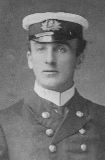
Ceredig Ellis, Second Lieutenant, Royal Welsh Fusiliers. Ceredig was the youngest son of David and Catherine Ellis, of Aberystwyth. Ceredig was a partner in a millinery and drapery business at Aberystwyth prior to the war, and had played football for Aberystwyth FC. He enlisted into the 15th Battalion, Royal Welsh Fusiliers, and whilst training at Colwyn Bay, met and married Mildred Cavanagh at Conwy in 1915, just prior to the battalions move to Winchester. The battalion was attached to 113 Brigade, 38th (Welsh) Division. On 4 December 1915 the battalion moved to France, and the entire Division moved to the Fleurbaix sector, where it was initiated into trench warfare. Ceredig had been commissioned as Second Lieutenant in the meantime, and joined the battalion at Cuinchy on 29 March 1916. During June 1916 the Division marched south to the Somme, and on 7 July 1916 attacked Mametz Wood. The initial attack failed, and it was three days later, on 10 July, that a fresh attack was mounted. Ceredig was wounded during the terrible fighting within the wood, and was evacuated to Abbeville, where he died of his wounds on 19 July 1916, aged 34. Ceredig is buried at Abbeville Communal Cemetery, France.
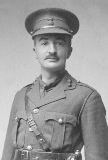
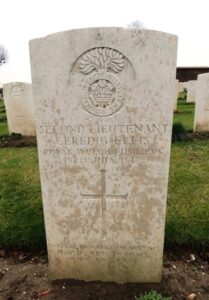
Oswald Robert John Green, Lieutenant, Welsh Regiment. Oswald was the son of William Arthur and Sophia Green of the Foundry, Aberystwyth, and the husband of Winifred Gwendoline Green, of Buchland House, Neath Abbey, Neath. George was educated at Jasper House and Aberystwyth University. He was a Holder of the Royal Humane Society Medal for life saving from drowning, and always to the fore in local sport, excelling swimming, cricket, golf and especially football. He was a successful captain of Aberystwyth Town Football Club prior to the war and spurned many offers to turn professional. A prominent trait was if any of the younger players was severely tackled, he always made a point of “protecting them”, a train of thought he was to take with him onto the battlefield. Oswald returned from America at the end of 1914 to take up a commission in the 9th Battalion, Welsh Regiment, which was attached to 58 Brigade, 19th (Western) Division. The Division moved to France during July 1915, and moved to positions near Loos, where it took part in the opening attack of the Battle of Loos on 25 September 1915. The following year the Division moved to the Somme, where it took part in the second wave of the attack on Ovillers-La Boiselle on 1 July 1916, capturing the village at heavy cost. The 9th Welsh had played a big part in the taking of Ovillers, but Oswald had been mortally wounded. He died on 5 July 1916, aged 35, as a result of his wounds, and is buried at Heilly Station Cemetery, Mericourt-L’Abbe, France.
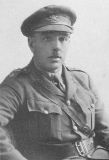
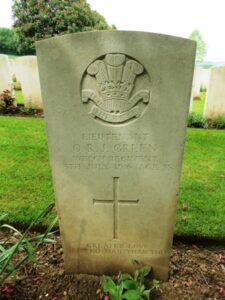
Richard Boycott Hinckesman, Lance Corporal, 497, King Edward’s Horse. Richard was born at Bridgenorth, Shropshire on 11 November 1886, the son of Thomas Boycott and Georgina Matilda Hinckesman (nee Vaughan). The family later resided at Tan y Graig, Trinity Road, Aberystwyth. An all round sportsman excelling at cricket and football, Richard played for Aberystwyth Town Football Club, before migrating to Canada. He returned home from Canada on 2 July 1914 to enlist into the King Edward’s Horse, a reserve Cavalry unit. It was mobilised on declaration of war and temporarily attached to 4th Cavalry Brigade. In April 1915, the regiment was split up, and the separate Squadrons attached to different Divisions. Richard died on 20 October 1915 while loading a wagon in a chalk pit, when a large pile of earth fell onto him. He had only recently been recommended for a commission. He was 28 years old, and is buried in Louvencourt Military Cemetery, France.
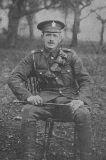
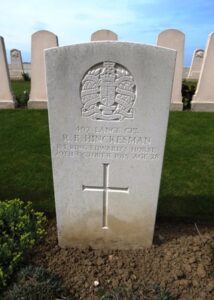
James John Herbert Howard, Lance Corporal, 19963, Royal Welsh Fusiliers. James was born in 1892, the son of Margaret Howard, of Mill Street, Aberystwyth. He was a faithful member of Tabernacle Chapel Sunday School and played football for Aberystwyth Town FC prior to the war. James originally enlisted at Aberystwyth into the 9th Welsh, but transferred to the 16th Battalion, Royal Welsh Fusiliers, which was attached to 113 Brigade, 38th (Welsh) Division. The Division had landed in France during December 1915 and had spent their first winter in the trenches near Armentieres. In June they marched south to the Somme, where they were tasked with the capture of Mametz Wood. The attack on the wood began on 7 July, but met with fierce resistance, and it took until 14 July to totally clear the wood. James suffered serious injuries to his leg and arm when a shell exploded near to him during the assault on Mametz Wood. Capt G D Ellis, his senior officer in the 16th RWF informed his parents that “there was little room to hope that he would recover”. James died on 12 July 1916, aged 23, and was buried in Carnoy Military Cemetery, France.
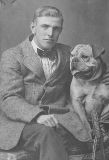
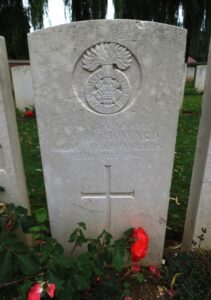
Evan Brindle Jones, Captain, Royal Welsh Fusiliers. Evan was the son of John Evan Jones and Lydia Brindle Jones, of Bradford House, Llangefni. He had played football for Aberystwyth prior to the war, and was commissioned into the 19th Battalion, Royal Welsh Fusiliers on 25 February 1916. The battalion moved to France in June 1916 attached to 119 Brigade, 40th (Bantam) Division, and moved to the front near Loos. Late in 1916 they moved south to the Somme, and fought at the Battle of the Ancre, remaining in the area over the winter. In March 1917 the Germans withdrew to the Hindenburg Line, and the 40th Division was one of the Divisions that followed the withdrawal. Later in the year they took part in the Battle of Cambrai, playing an important role in the attack on Bourlon Wood. They remained in the area over the coming months, but were caught here by the German Spring Offensive of 21 March 1918, and saw terrible fighting over the coming days. Evan was wounded early in 1918, and was evacuated to England for treatment. He died of his wounds at home on 10 November 1918, aged 25, and is buried at Llangefni Cemetery.
Leigh Richmond Roose MM, Lance Corporal, PS/10898, Royal Fusiliers. Leigh was born on 27 November 1877, the son of Richmond Leigh Roose and Eliza Roose, of Holt, Denbighshire. He studied at Aberystwyth University prior to the war, but interrupted his further studies to concentrate on his real love, football, and became a well respected goalkeeper. He began his career at Aberystwyth FC, before playing for several clubs, including Everton, Stoke, Celtic, Arsenal and Sunderland, and gaining 24 Wales international caps. He was patriotic, and enlisted into the Royal Fusiliers at the outbreak of war under the name of Leigh Rouse, being posted to the 9th Battalion, which was attached to 36 Brigade, 12th (Eastern) Division. Leigh joined the battalion in France in 1916, and saw his first action during the divisions attack on Ovillers on 2 July. On 6 August his battalion was in the front line near Ration Trench, Pozières, when it was counter attacked by the Germans. Leigh was at the forefront of his battalions’ brave defence of their trench, and was recommended for the Military Medal. On 7 October his battalion took part in an assault against Gueudecourt, and at sometime during the attack, Leigh was killed. His body was never found, and he is commemorated on the Thiepval Memorial, France. He was 38 years old.
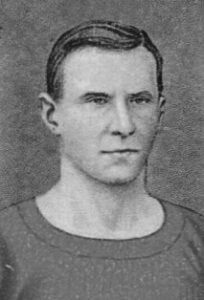
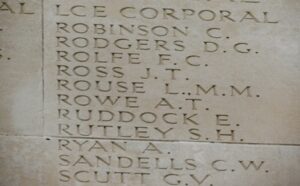
Hugh Owen Rowe, Pioneer, 82545, Royal Engineers. Hugh, who was known locally as Hughie, was born at Aberystwyth in 1896, the son of John Hugh Rowe, musical director of the town band, and Elizabeth Rowe of Glencairn North Road, Aberystwyth. Hughie had played football for Aberystwyth Town FC prior to the war. He enlisted in 1915 into the Royal Engineers, and was posted to France early in 1916, joining the 8th Division Signal Company, Royal Engineers. The 8th Division was on to the Somme in 1916, where they fought at the Battle of Albert. In March 1917 they followed the German Retreat to the Hindenburg Line, and later that year moved to Ypres, fighting at the Battle of Pilckem, and the Battle of Langemarck. In March 1918 the Division was on the southern end of the Somme, and here met the German Offensive head on, at the Battle of St Quentin, desperately fighting a rearguard action over the coming days, before being withdrawn from the line to rest. Hughie took ill with influenza during this period, and was evacuated to Étaples where he was hospitalised. Hughie was 22 years old when he died of influenza at the 51st General Hospital at Etaples on 5 May 1918. He is buried at Étaples Military Cemetery, France.
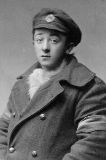
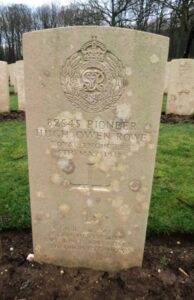
World War Two, 1939-1945
Thomas Brinley Edwards, Lance Serjeant, 984699, Royal Artillery. Brinley was born on 4 February 1914, the son of Hugh Jenkin Edwards, and of Anne Marie Edwards (nee Jones), of Aberystwyth, and had played football for Aberystwyth FC prior to the war. He served with 11 (Honourable Artillery Company) Regiment, Royal Artillery, which served in North Africa, equipped with Priest self-propelled guns. Brinley was taken prisoner after the fall of Tobruk, and was handed over to the Italians. He was among a number of POWs taken aboard the S.S. Scillin, which sailed from Tripoli for Italy on 14 November 1942. During the night the ship was torpedoed and sunk by the Royal Navy Submarine HMS Sahib, and 783 POWs drowned. Thomas was 28 years old when he died that night, and is commemorated on the Alamein Memorial, Egypt.
Linus Evans, Captain, 217383, Royal Welch Fusiliers. Linus was the son of John and Eleanor Evans, and the husband of Margaret Magdalen Elizabeth Evans, of Aberystwyth. He played football for Aberystwyth FC prior to the war, before becoming commissioned into the 6th Battalion, Royal Welch Fusiliers. The battalion landed on the Normandy beaches on the end of June 1944, attached to the 53rd (Welsh) Division, and took part in the break-out from the Normandy beach-head. It then played an important role in the advance through Northern France into Belgium and Holland. Linus was killed whilst fighting around the Reichswald Forest on 8 February 1945. He was 32 years old, and is buried at Reichswald Forest War Cemetery, Germany.